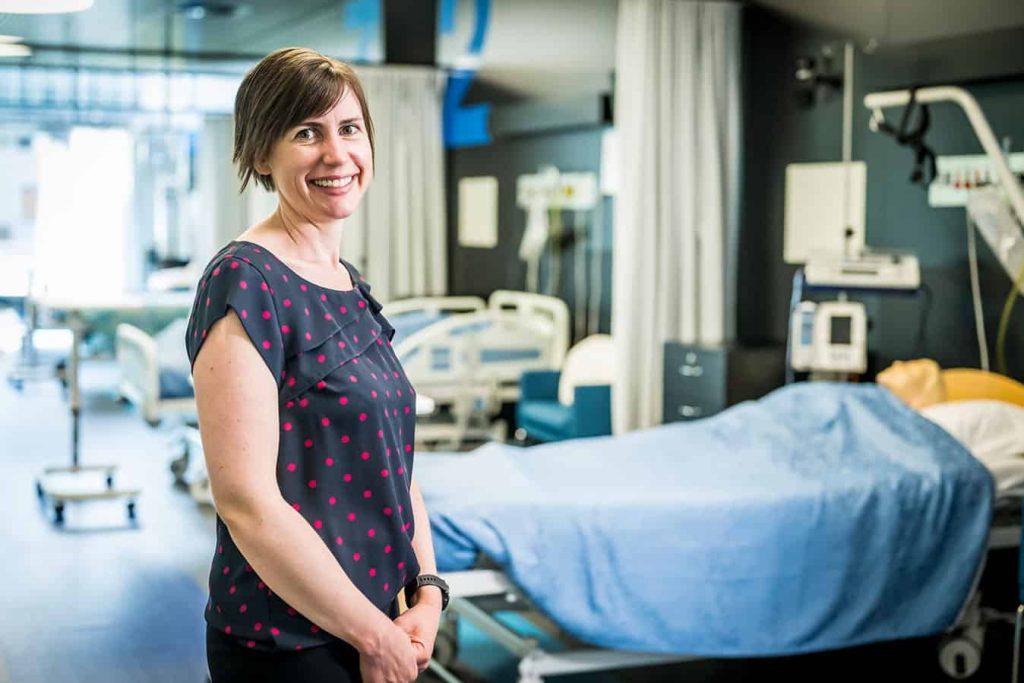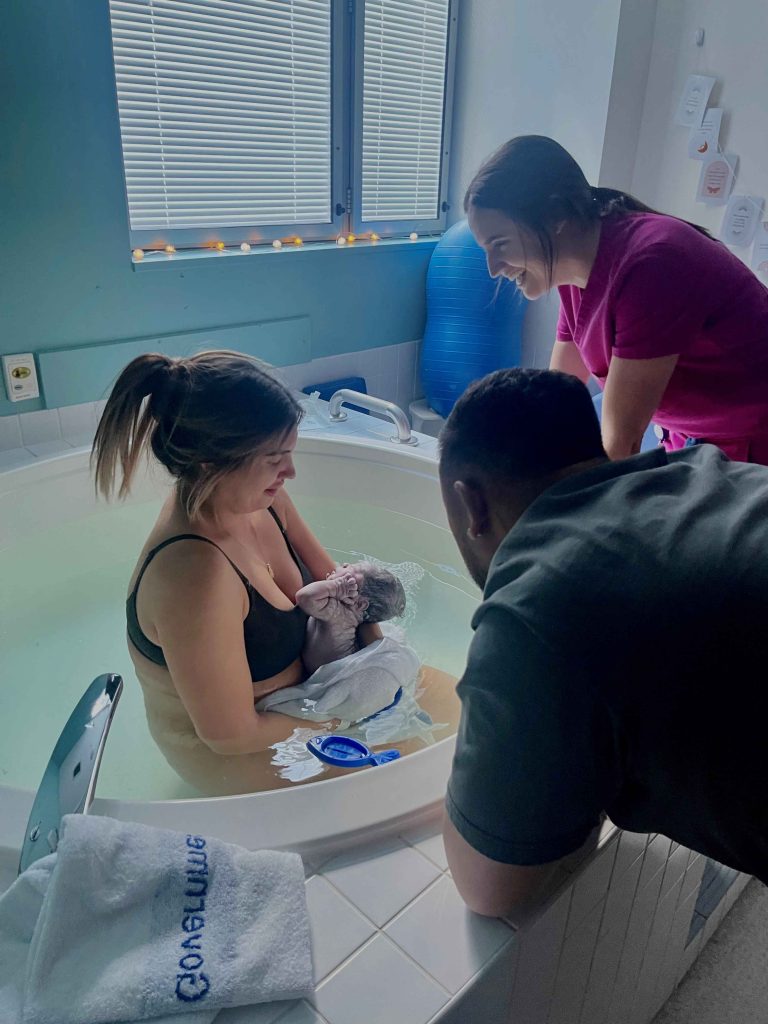After more than two decades in the public health system, midwife Di Longworth ventured into private practice, offering midwifery services, including homebirths, to her local community in Singleton, in the Hunter Valley in New South Wales.
Her decision was motivated by a strong belief in providing rural and regional women with more birthing care choices and a deep-seated philosophy that birth is a normal, safe event.
Di provides midwifery care to about 20 women every year who give birth at home.
“Women who choose this model of care have a belief in their body’s ability to birth and that it’s generally not a medical event, it’s more of a social and a family event,” she explains, of why some women make the choice.
“They like to keep it in that sphere and avoid the potential trauma of interventions in the hospital system. The hospital system obviously needs to work in a way where there are protocols and procedures with people following a certain pathway. With private midwifery care, it’s individualised care.”
Being part of the home birth experience is “extra-special” Di says.
“Women realise their power and that they’ve actually been entirely able to do it themselves and we’re kind of just there as guardians of the birth in case there’s a problem.”
However, proposed changes recently announced by the federal government could restrict the practice of Di and around 200 other privately practising midwives who provide home birthing services across Australia. This would potentially force pregnant women seeking this model of care to turn to the hospital system or other alternatives.
The issue arose after the government announced plans to revamp professional indemnity insurance (PII) for privately practising midwives.
Since 2010, PPMs have had access to government-supported PII for antenatal and postnatal care, purchasable exclusively from Medical Insurance Group Australia (MIGA), which does not cover intrapartum care for planned homebirths.
An exemption from PII arrangements for intrapartum care for privately practising midwives providing home births has been in place since then. The government recently announced that this exemption will cease on 30 June 2025, and MIGA will provide home birth insurance within a low-risk framework with consultations to take place before the end of the year to determine the parameters. The government indicated their support for an insurance product for ‘low-risk’ homebirth for PPMs. This proposal of a low-risk framework has raised concerns among PPMs and midwifery professional bodies who fear it may limit women’s access to midwifery care, who provides their maternity care, and where they give birth, including at home.
Di estimates that a third of the women she cares for annually would fall outside the proposed ‘low-risk’ category as defined by Australian College of Midwives (ACM) guidelines. She points out that the guidelines were meant as benchmarks for midwives to follow and seek advice or help when needed, not as an exclusion tool.
“Even a woman who develops some degree of anaemia in her pregnancy would potentially be ruled out if they used that tool as the guide for what they consider low-risk,” argues Di.
“There are women who have a slightly increased risk of conditions or adverse events that will still choose to birth at home. They accept that physical risk, albeit small, may well be worth taking rather than going into the hospital system and potentially risking birth trauma, potentially risking coming through the experience with depression and anxiety. We know that the interventions that are done in hospital are often the cause of further morbidities as well. So, a lot of women feel that they’re actually protecting themselves, rather than putting themselves at risk.”
The Australian Nursing and Midwifery Federation (ANMF) is lobbying on behalf of PPMs and the wider midwifery profession to address the issue. The union is calling on the government to immediately commence consultations on the proposed framework with key stakeholders to ensure midwives can provide effective care to women birthing after 1 July 2025, once the exemption ends. Ideally, they want no restrictive criteria, maintaining and respecting midwives’ expert assessment and decision-making skills.
“If this goes ahead, the perception will be that all midwives can do is provide a narrow scope of care, when they can actually do a lot more,” says ANMF Federal Professional Officer Naomi Riley.

“A rigid framework is also saying you can only do this, ignoring that midwives are autonomous practitioners who can recognise their scope of practice and are skilled in assessment and critical decision-making, including preparing for adverse events and escalating care when needed. It also ignores the nuances of individualised care and that women may present with “risk factors” that sit outside a “low-risk” framework however primary care provider and place of birth does not change the management.”
Placing restrictions on PPMs’ care also has broader implications for the midwifery profession, including the acute public sector, Ms Riley says.
“If PPMs are confined to a limited scope of practice, it suggests this is the scope of all midwives. While it affects a small number of PPMs now, it could reduce the scope of all midwives.”
Di fears for women’s choices and PPMs right to earn an income.
“Women deserve options rather than being pushed into a system,” she says.
“The thing is many of them won’t be pushed into the system. There’s a growing movement of women out there who are choosing to free birth without any professional care at all. In most cases it will all work out well but, in the situations, where it doesn’t, [it’s a shame] that they won’t have that little bit of assistance there when it’s needed.”
Di is also upset that the ‘low risk’ criteria ignores that midwives are safe, autonomous practitioners who can effectively plan and escalate in emergencies.

“We’ve done additional training. We’ve done more than 5,000 hours in the system. We’ve done additional qualifications. We have those advanced skills and advanced knowledge. To be limited because of a decision made by politicians who don’t understand how we work [is disappointing]. It’s restricting not only on our ability to earn an income, but also on our ability to continue caring for the women. They may start off with our care and then develop a small issue, then be risked out of our care and thrown back into the hospital system, which can be really upsetting, especially for women with previous birth trauma.”
Brisbane-based PPM Ashleigh Sullivan, who works within a First Nations model of care, also worries about the changes. She provides care to about 32 women each year.
“It’s going to create an extra layer of red tape for midwives who have essentially gone into private practice to have more autonomy,” Ashleigh says.
“It’s going to take away a midwife’s ability to manage risk, particularly in the home birth space. But it’s also going to alienate some women from birthing at home who aren’t necessarily ineligible to birth at home because the risk framework that they’re using was never meant to dictate where a woman births.”
Ashleigh’s workplace doesn’t currently offer home birth but would like the option in the future. Under the potential changes, many First Nations women may fall outside the ‘low-risk’ criteria.
“You’re essentially saying that a lot of these First Nations women will never have the opportunity to birth on country because this risk framework really excludes them.”
Di and other PPMs are hoping for a sensible solution that doesn’t limit women’s access to care.
“The powers that be making these decisions need to understand how we work and how women accessing midwifery care like to be involved in their care and value their autonomy,” Di says.
“Listen to the women and midwives on the ground to find a sensible solution.”









7 Responses
As above! I too am a PPM who is most concerned that the autonomy of women and Midwives is under threat. Women need to be supported in their choices once the risks and benefits have been fully explained to them. Astronauts have a 1:6 chance of dying if they choose to head into space, but it’s THEIR decision – no-one else’s!
The ACM guidelines for collaboration and referral really need review and updating. Many women falling into a category B and even a select C are still able to birth at home with appropriate counseling and ensuring records of understanding are documented appropriately.
High risk, defined by whom? Those who continuously have an opinion, which appears to have greater persuasion, or current evidence base which, when not suited to one’s objectives or agendas is overlooked.
But the consultation and referral guidelines are guidelines for criteria and how to manage certain situations, not a guide to exclude people from home birth. That’s what is sad to see because these guidelines serve a good purpose to seek advice on certain conditions, however they are being weaponised to create an exclusion criteria for home birth in this instance.
Great to see this published. Please keep profiling this issue and ensure women have choices and midwives scope of practice.
Thanks to the ANMF for your advocacy on this issue. Midwives who work outside of the hospital system are often overlooked. It’s nice to be seen and heard. Hopefully we survive this potentially devastating change for our women and our livelihoods!
So many women like me chose homebirth with a PPM precisely because we had “risks” that placed additional, non-evidence based requirements on us if we chose to birth in hospital. These would have restricted my choices and my ability achieve the births I wanted. Birthing at home was uneventful and everything I wished for. Had I been forced to birth in hospital, I would have found myself with less choice, higher risks and statistically poorer outcomes, especially since one of my births was precipitous. Many women choosing to birth at home with a PPM are refugees from a strained hospital system that does not provide continuity of care.
The ACMI guidelines need a serious overlook. Women like myself who are a C (for an incidentally found “issue” with no treatment or management whatsoever) make an informed decision to birth at home as this is where we feel SAFE. Mind you I’m also a midwife. I’ve now seen and lived both worlds and I can tell you now I would not choose to birth in hospital even IF I was risked out of a home birth model with a PPM. Me like many others would choose alternate pathways.
Stop trying to dictate how women birth. It is a human right.
My PPM was a godsend in so many ways , I would not have received the support I did antenatally , intrapartum and postnatally in a hospital model like I did with a PPM.